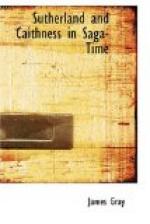[Footnote 9: So called because he wore the kilt, in its original form, not the philabeg.]
[Footnote 10: Magnus Saga, 10, 11 and 20. The story of this time is confused and difficult. Torfaeus, trans., p. 85 and Torfaeus Orcades, c. xviii. From c. 20 of Magnus Saga the Longer it is clear that Hakon in 1112 took Paul’s share of Caithness also and Magnus took Erlend’s share, and that they divided that earldom and lands.]
[Footnote 11: O.S., 45.]
[Footnote 12: Magnus Saga the Longer, c. 10 to 28. O.S., c. 46 to 55. There is little doubt but that Magnus was the Scottish candidate for Caithness, and Hakon the Norse favourite, and Hakon had to conquer Cat.]
[Footnote 13: Who was Dufnjal? What does “firnari en broethrungr” mean? Who was Duncan the Earl? Possibly the Norse expression means half first cousin, and if Dufnjal was Earl Duncan’s son, the relationship was through Malcolm III, and Dufnjal was a son of King Duncan II, called “Duncan the Earl,” of whom, however, the O.S. and Longer Magnus Saga say nothing in this connection. But see Henderson, Norse Influence, &c., p. 26 contra.]
[Footnote 14: Paplay, Thora’s home, was probably in Firth Parish in mainland, near Finstown. Short Magnus Saga, c. 18, not “twenty,” but twenty-one years after his death. See O.S., c. 60. But vide Tudor O. and S., pp. 251-2 and 348. See also Anderson’s Introduction, p. xc, to Hjaltalin and Goudie’s O.S. contra.]
[Footnote 15: Viking Club Miscellany, vol. i, pp. 43-65 (J. Stefansson), but the authorship is disputed.]
[Footnote 16: O.S., 47]
[Footnote 17: O.S., 48. Both Hakon and Magnus were about five-sixths Norse.]
[Footnote 18: O.S., c. 55; Magnus Saga, 30.]
[Footnote 19: O.S., 56.]
[Footnote 20: See Reg. Dunfermelyn, No. 1 and 23 (p. 14); Lawrie, Scot. Charters, pp. 100, 179; Viking Club, Caithness and Sutherland Records, p. 18, the note to which seems correct. “The Earl” was Ragnvald, who ruled as Harold’s guardian at this time, in Caithness also. Durnach is now Dornoch.]
[Footnote 21: Reg. Dunfermelyn, No. 24 (p. 14). Supposed to be the Huchterhinche of St. Gilbert’s Charter to the Cathedral of Durnach. Sutherland Book, iii, p. 4.]
[Footnote 22: Dunbar, Scot. Kings, pp. 51, 60, 61, 63. The name is spelt “Fretheskin” also.]
[Footnote 23: Possibly 1120.]
[Footnote 24: See History and Antiq. of the Parish of Uphall by the Rev. J. Primrose (1898).]
[Footnote 25: Family of Kilravoch, p. 61. Robertson, Early Kings, ii, 497, note.]
[Footnote 26: See Familie of Innes (Spalding Club), pp. 2. 51, 52.]
[Footnote 27: Sutherland Book, vol. I, p. 7, and see map of Cat.]




